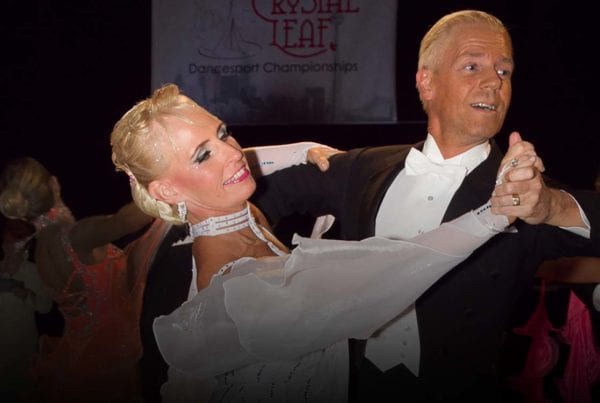The Samba started out as a dance known as the “Maxixe.” It’s name was changed to Samba somewhere around 1914. By 1928 it had grown popular enough in Europe that the steps were formally published.
In 1933, movie audiences in the US were first exposed to an early version of the Samba when Fred Astaire and Dolores Del Rio danced the Carioca in Flying Down to Rio. You can see some of the distinctive characteristics still used in the dance today even in this early version.
In 1941, Carmen Miranda danced the Samba in That Night in Rio. Audiences were not yet ready in those days for the amount of hip movement we see in today’s Samba.
By this time, interest in the Samba was already high as Samba music had been played at the Brazilian Pavilion of the 1939 World’s Fair in New York. The Brazilian composer Ary Barroso wrote the classic Samba, “Brasil,” which quickly became a hit and established the characteristics of the Samba beat.
The Samba has grown and evolved with more energy and hip movement, but the best Samba dancers continue to draw from its roots in musicality. Below is an excellent example of the Samba:
Samba can be challenging to learn because it requires technical control and has several different rhythms. One aspect of the dance is the “Samba Bounce” which is accomplished by using the ankles and knees to create a bouncing action while keeping the head level. Many figures used in the Samba today require a pelvic tilt action known as the “Samba Tic.” This action is difficult to accomplish, but without it the dance loses much of its effect. Because the leading and following can be difficult and require a sensitive touch from both partners, most social dancers learn the Samba by using a series of groupings or a routine.
Primary Steps
Dancing the Samba requires knowledge of five basic step patterns. These are the Samba Basic, the Whisk, the Samba Walk, the Volta and the Bota Fogo. With those five steps, couples can easily begin to dance around the floor. The Samba moves counter-clockwise as do the Standard dances like the Waltz. Many of the more complex steps also utilize these five basic steps in different ways. For example, the Roundabout is composed entirely of Voltas and Bota Fogos, put into a special pattern to create a new step. Likewise the Maypole uses Voltas danced in a turn.
Advanced Program
The Samba is introduced introduced and taught in a special 6-lesson series in Delta’s Advanced Program. The program covers the basic steps with plenty of technique. We teach a routine that moves around the room. It will stretch you but isn’t terribly difficult for dancers who are comfortable with Bronze-level steps. Join us! The Advanced program happens on Tuesday nights in KinVillage and on Thursday nights in North Delta.
If you’re interested in learning more about the Samba, a great overview of Samba history is available here.












